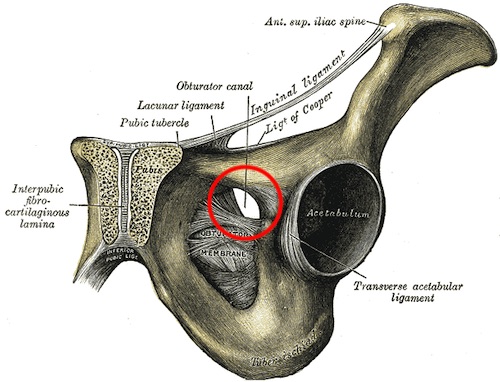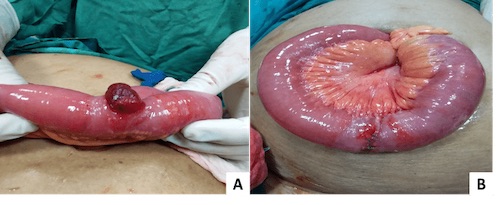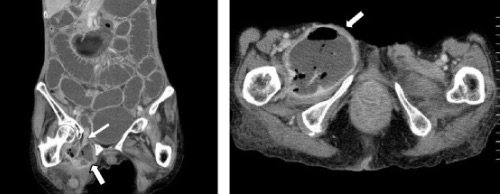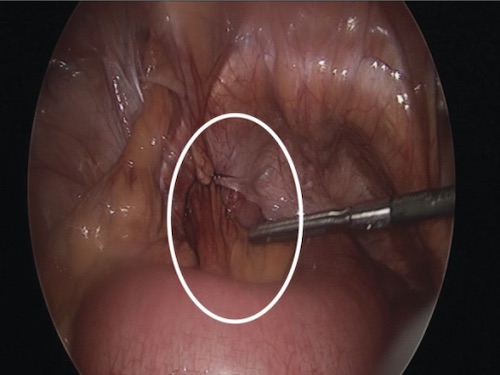Obturator Hernia
Ronald C. Speirs, MD
The Operative Review of Surgery. 2023; 1:314-317.
Table of Contents
Pathophysiology and Presentation
Definition
- Hernia Through the Obturator Foramen
- Obturator Foramen Anatomy:
- Located on the Anterolateral Aspect of the Pelvic Wall
- Mostly Covered by a Fibro-Osseous Membrane
- Open at the Anterosuperior Aspect – The Obturator Nerve, Artery, and Vein Enter the Obturator Canal
- Very Rare (< 1% of Abdominal Wall Hernias)
- High Morbidity and Mortality (15-25%) 1
- Due to Delayed Diagnosis and Bowel Infarction
- Most Often a Richter Hernia: Only the Antimesenteric Border of the Bowel Wall is Herniated 2
- May Not Cause Obstruction as Bowel Contents Can Pass Through the Intraperitoneal Portion of the Bowel
- High Risk of Incarceration and Strangulation of the Herniated Portion
Risk Factors 3-7
- Loss of Preperitoneal Fat in the Obturator Canal Due to Cachexia or Profound Weight Loss
- 9x More Common in Women (Wider Pelvis with Larger Obturator Canal)
- Elderly (70-90 Years Old)
- Multiparous
- 2x More Common on the Right – Left Covered by the Sigmoid Colon
- *Nicknamed “Little Old Lady’s Hernia”
Other Groin Hernias
- Inguinal Hernia
- Femoral Hernia
- Athletic Pubalgia (Sports Hernia)
- *See Athletic Pubalgia (Sports Hernia)
- Not a True Hernia
- *96% of Groin Hernias are Inguinal, 4% are Femoral 8,9
Presentation
- Clinical Presentation is Generally Nonspecific and Preoperative Diagnosis Can Be Difficult
- Rarely See Proximal Thigh Mass Between the Pectineus and Adductor Longus Muscles – May Be Confused with a Femoral Hernia
- Obturator Neuralgia – Ipsilateral Groin Pain Radiating to the Medial Knee
- Due to Compression of the Obturator Nerve
- Recurrent Episodes of Bowel Obstruction
- Cramping Abdominal Pain
- Nausea and Vomiting
- Constipation
- Risk for Bowel Incarceration, Strangulation, and Necrosis

Obturator Foramen 10

Richter Hernia 11
Diagnosis and Treatment
Signs of Obturator Neuralgia/Hernia
- Howship-Romberg Sign 12
- Ipsilateral Medial Groin/Thigh Pain Aggravated by Extension, Abduction, and Internal Rotation
- Hannington-Kiff Sign 13
- Absent Adductor Reflex with Positive Patellar Reflex
- Adductor Reflex: Tapping of the Medial Epicondyle of the Femur Incites Hip Adduction
- Patellar Reflex: Tapping of the Patellar Tendon Incites Knee Extension
Diagnosis
- Imaging (CT, US, or MRI) Generally Used to Confirm Preoperative Diagnosis
- May Be Diagnosed Intraoperatively During Exploration of a Bowel Obstruction 14
Treatment
- All Should Undergo Early Surgical Repair Regardless of Symptoms
- Higher Risk of Incarceration and Strangulation Preclude Watchful Waiting
Surgical Approach
- Minimally Invasive (Laparoscopic/Robotic) Hernia Repair
- *See Minimally Invasive Inguinal Hernia Repair
- Often Considered the Preferred Method of Repair in Elective Cases
- Open Midline Laparotomy
- Generally Preferred in Cases of Bowel Ischemia/Necrosis
- Other Options:
- Open Inguinal Approach
- Open Obturator Approach
- Bowel Reduction May Require Incision of the Obturator Membrane – Done at the Inferior Margin and Extended Inferomedial to Avoid Injury of the Nerve/Vessels 15

Right Obturator Hernia Seen on CT 16

Left Obturator Hernia (Circle) with Incidental Femoral Hernia at 11 O’clock Position 17
References
- Mindaye ET, Giduma D, Tufa TH. Obturator hernia: case report. J Surg Case Rep. 2020 Oct 19;2020(10):rjaa389.
- Treves F. Richter’s Hernia or Partial Enterocele. Med Chir Trans. 1887;70:149-67.
- Mandarry MT, Zeng SB, Wei ZQ, Zhang C, Wang ZW. Obturator hernia–a condition seldom thought of and hence seldom sought. Int J Colorectal Dis. 2012 Feb;27(2):133-41.
- Kammori M, Mafune K, Hirashima T, Kawahara M, Hashimoto M, Ogawa T, et al. Forty-three cases of obturator hernia. Am J Surg2004;187:549–52.
- Mantoo S, Mak K, Tan T. Obturator hernia: diagnosis and treatment in the modern era. Singap Med J2009;50:866–70.
- Kulkarni SR, Punamiya AR, Naniwadekar RG, Janugade HB, Chotai TD, Singh TV, et al. Obturator hernia: a diagnostic challenge. Int J Surg Case Rep2013;4:606–8.
- Goon HK, Bahari HM. Obturator hernia: a case report. Med J Malaysia1983;38:200–2.
- Rutkow IM, Robbins AW. Demographic, classificatory, and socioeconomic aspects of hernia repair in the United States. Surg Clin North Am. 1993 Jun;73(3):413-26.
- Lockhart K, Dunn D, Teo S, Ng JY, Dhillon M, Teo E, van Driel ML. Mesh versus non-mesh for inguinal and femoral hernia repair. Cochrane Database Syst Rev. 2018 Sep 13;9(9):CD011517.
- Gray H. Anatomy of the Human Body (1918). Public Domain.
- Abo-elmagd A, Ahmed K. Richter Paraumbilical Hernia Managed by Invagination: A Case Report and Review of Literature. Am J Surg Case Reports. 2019. (License: CC Unspecified)
- Howship J. Practical Remarks on the Discrimination and Appearance of Surgical Disease. London, Churchill, 1840.
- Hannington-Kiff JG. Absent thigh adductor reflex in obturator hernia. Lancet. 1980 Jan 26;1(8161):180.
- Salameh JR. Primary and unusual abdominal wall hernias. Surg Clin North Am. 2008 Feb;88(1):45-60, viii.
- Stamatiou D, Skandalakis LJ, Zoras O, Mirilas P. Obturator hernia revisited: surgical anatomy, embryology, diagnosis, and technique of repair. Am Surg. 2011 Sep;77(9):1147-57.
- Kubo N, Yoshizawa Z, Hanaoka T, Nakamura K. A case of a perforated obturator hernia with a femoral abscess treated a pectineus muscle flap. BMC Surg. 2015 Oct 2;15:107. (License: CC BY 4.0)
- Lynch NP, Corrigan MA, Kearney DE, Andrews EJ. Successful laparoscopic management of an incarcerated obturator hernia. J Surg Case Rep. 2013 Jul 23;2013(7):rjt050. (License: CC BY-NC 3.0)